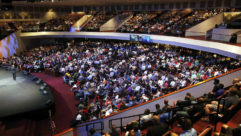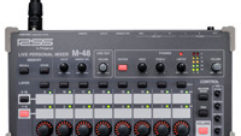
Roland S-4000
Dec 1, 2006 12:00 PM,
By John McJunkin
Digital snake system tames latency-prone audio transmission.

The whole audio world has gone digital. First, it was signal processing, then it was recording devices, and then consoles, and now it’s the venerable snake. In the past, how many huge, heavy snakes have you reeled up and carted out, cussing and snarling about weight and unwieldiness? Moving an increasing number of signals over ever-shrinking cable has always been one of the promises digital has made to industry professionals, but that promise has never been truly fulfilled due to the final stumbling block — latency. I don’t know about you, but I just can’t have my signal arriving at the amplifiers 35 milliseconds after it originated.
With the S-4000 digital snake system, however, the folks at Roland have now reduced latency to substantially less than 1 millisecond, and I can certainly live with that.
COMPONENTS
The components comprising the system are the S-4000S 40-channel I/O modular rack, the S-4000H 32×8 FOH unit, the S-4000R remote controller, and the snake itself, which is a Cat-5e crossover cable of up to 100m. in length (a 10m. cable is included). Forty channels of 24-bit/96kHz audio (32 from stage, eight returns) can be handled by this tiny little wire. The transmission distance can be increased with Ethernet switching hubs, and Roland makes system control software available for both Windows and Mac platforms — I would love to see every manufacturer do this. The system also features two connection paths (primary and redundant). A redundant backup power supply (S-240P) is also available.
The S-4000S modular rack is the system’s “stage box,” with 32 inputs in banks of four (eight SI-AD4 modules, specifically). Each input has an XR-1 variable-gain preamp (remotely adjustable by computer or remote controller) that accepts signals ranging from -65dBu to +10dBu (for a maximum of +28dBu). Three status LEDs on each input indicate phantom power, signal presence, and clipping. Two SO-DA4 output modules provide eight outputs from FOH with a +4dBu typical output, +22dBu maximum.
The rack also has two Roland Ethernet Audio Communication (REAC) ports by which the unit is connected to the Cat-5e snake(s). The second port is for redundancy. A REAC Mode switch determines whether the unit operates in master, slave, or split mode. There is also MIDI I/O, a nine-pin D-sub (RS-232C) connector by which to connect the system’s remote controller, LEDs indicating REAC and remote controller connection, and a Mute All Outputs button to enable safe connection of signals. Finally, a power-oriented section features LEDs indicating internal vs. external power or a problem with the system, and of course a power switch.
The S-4000H is normally situated at FOH, serving as the breakout box to feed your console. It features two REAC connectors (primary and redundant); these are the brilliant Neutrik EtherCon RJ-45 units, which help ensure a robust connection, but standard RJ-45 plugs can also be used. As with the S-4000S, a REAC Mode switch determines operation mode. And again, there is MIDI I/O, the nine-pin RS-232C connector for the remote controller, and LEDs indicating REAC and controller communication status. There is an all-important Mute All Outputs button on this end of the operation, as well, along with power status and alarm indicators and a power switch. Most important are the input and output connectors, which are DB-25 connectors intended for breakout cables. Roland has breakout cables available, but you can certainly build your own if you care to do so.
The S-4000R remote controller is intended to provide control over each of the system’s input channels. Memory buttons scroll through the unit’s 10 memory locations, and recall and store buttons execute their respective commands in regard to memory. I find this very handy. Say you have a nightclub scenario where a handful of four or five bands rotate through the club. You can store each band’s nominal level settings in the system and recall them with the press of a button.
A knob and LED display adjust and indicate which channel is currently being adjusted. One minor complaint here — it appears that this controller was designed by a left-handed engineer. When adjusting level with one’s right hand, the level display is obscured just at the moment when it needs to be visible. It’s certainly not a deal killer, but perhaps future revisions will move the meter to a location that is always visible during adjustment. A lock button disables alterations to channel settings. The unit’s “clip clear/enter” button clears clipping indicators in the display, and also serves as the unit’s enter button to finalize a selection. A pad button engages a 20dB pad on the selected channel, and similarly, the Phantom +48V button applies phantom power to the selected channel. There is a gain knob and an eight-segment LED level meter that applies to the currently selected channel, as well.
There are signal status LEDs for each of the system’s 40 channels, indicating signal presence and clipping. There are also power and system status indicators, showing REAC and controller communication.
USING THE SNAKE
I spent time test-driving the Roland digital snake at the Conservatory of Recording Arts and Sciences in Gilbert, Ariz. This system is configured to not only provide signal transfer from FOH to stage and back, but also a split to the monitor console. There are plans to implement a recording split.
The initial connection of the system is simple. The stage box is, for all practical intents and purposes, no different from any other stage box I’ve used. It’s just a matter of plugging in your signals like you normally would. Signal levels are typically dialed up with the remote controller, although the computer software provides better metering. And once all levels are established, they can be stored. As I said before, that’s a nice convention.
Although a second, redundant REAC cable is used at the Conservatory, the primary cable has never failed in many months of use. I was particularly impressed with the clever use of a standard Ethernet switcher, which costs approximately $20, to split the snake’s signals off to the monitor console.
A second S-4000H unit breaks the signals out for monitoring purposes. The system has been 100 percent bulletproof, and frankly, sounds great. With 24-bit/96kHz resolution, one simply forgets that the signal is being converted A-D/D-A en route. It sounds good enough that the illusion of analog signal flow is sustained. Along those lines, I still find myself utterly astonished at the 0.375-millisecond latency when using a Roland REAC cable. From my perspective, anything less than a millisecond is acceptable.
Latency has been the bane of digital signal transfer since the dawn of time, but now Roland has solved the problem and applied the solution in a practical, eminently usable way with the Roland digital snake. If you have any reason whatsoever to avoid running incredibly thick, heavy cabling, this is the alternative you’ve been waiting for.
PRODUCT SUMMARY
Company: Roland Systems Group www.rolandsystemsgroup.com
Product: S-4000
Pros: Low latency, high resolution, software for both platforms.
Cons: Remote controller’s meter can be obscured by right-handed engineers.
Applications: For all audio professionals wanting the next generation in digital transmission.
Price: $7,995
SPECIFICATIONS
Frequency Response: 20Hz to 20kHz at +4dBu
THD+N (Pad On/Gain +4dBu): 0.05% or less
Dynamic Range: 110dB
Cross Talk: -80dB
Nominal Input Level: -65 to -10dBu (Pad off), -45 to +10dBu (Pad on)
Maximum Input: +28dBu
Input Impedance: 20kΩ
Nominal Output Level: +4dBu, +22dBu maximum
Output Impedance: 150Ω
Recommended Load Impedance: 10kΩ or greater
Residual Noise Level (IHF-A, typical): -92dBu
Equivalent Input Noise (E.I.N.): -128dB
Network Latency: 0.375ms (using REAC cable only)
John McJunkinis the principal of Avalon Audio Services in Chandler, Ariz. He consults in the development of studios and installations and provides a large variety of recording and production services.









